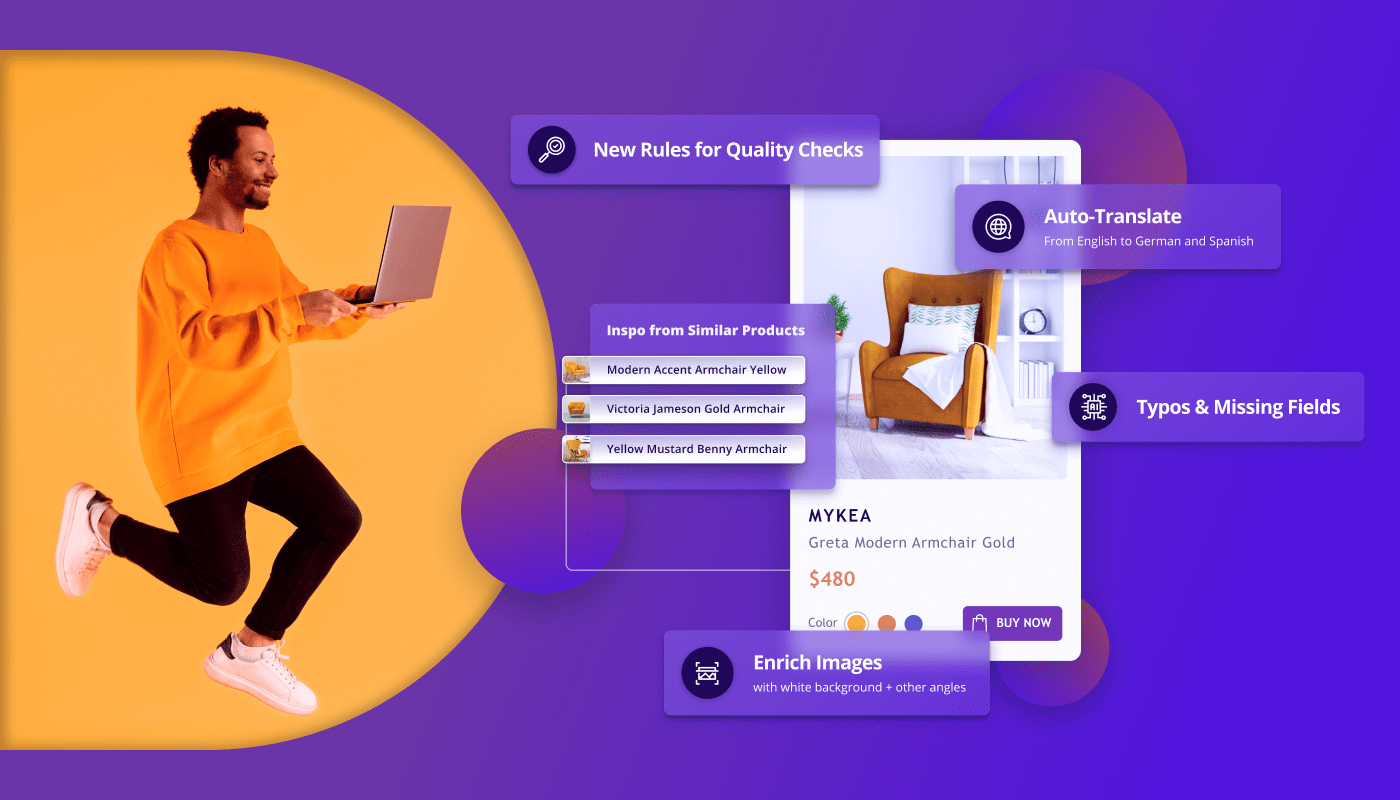As the global ecommerce market is estimated to reach $5.5 trillion worldwide, everybody wants to dig into the opportunity to establish a global presence. To stay competitive and recession-proof, online retailers are looking for optimal ways to expand into new geographies. Localization is the ultimate prerequisite for borderless commerce and successful global expansion.
Without a doubt, localization is a tough nut to crack — as it can be very time and resource-consuming. It is important to make your site accessible and engaging for your new market while maintaining consistency with brand messaging and design elements across all platforms.
Here is our 7-part checklist outlining key areas to focus on to click with the right customers and conquer new territories fast:
1. Content in Shoppers’ Preferred Language
According to CSA Research, 76% of online buyers prefer to purchase products that include information in their own language. A further 40% claimed they will never make a purchase from a website that is in another language. In other words, the absolute first step in your globalization journey should be to make your product content available in the local language.
Direct translation of your existing content is a solid starting point as long as you make sure the meanings are preserved.
With some literal translations, you may end up conveying the wrong message and providing inaccurate content. For example, “Kindergarten” in German is literally translated to “children’s garden” in English when in reality it means preschool. In translating content, you must account for differences in culture, grammar, syntax and sentence structure.
This applies to user-generated content (UGC) as well. 63% of users are more likely to make a purchase if product reviews are available, and they are 12 times more likely to believe product reviews than product descriptions. In translating your website’s content, it’s crucial to include translated reviews to build credibility and gain customer trust.
2. The Must Haves: Payment and Support
Payment methods and preferences vary globally. The most prevalent online payment options in Argentina provide a voucher that can be paid offline, whereas nearly 7 out of 10 transactions in the Netherlands are completed through iDEAL, a domestic payment system.
To provide a smooth purchasing experience without any hidden costs, it is important to ensure that the payment methods you offer are accepted in the country you are selling to, and that they correspond with the local currency.
Different countries also have different tax rates and regulations. When entering a new market, it is critical to calculate taxes and display them in a clear and transparent manner for your customers. As an ecommerce business, you must be able to set the proper tax rules and rates, update and publish any changes to the rates, and gather all the data required to ensure that your operation complies with local laws.
Finally, we cannot stress enough the importance of localizing support options. If customer service is provided in their native language, 75% of customers are more inclined to make another purchase. To effectively support your customers, you can start small by creating an FAQ page in your target market’s language, then work your way up to building a local support team or investing in multi-lingual AI-powered support tools.
3. Adapt to the Local Culture and Expectations
To provide your customers with a better and more familiar shopping experience, your product strategy must incorporate the local cultural nuances. Consider language, special occasions and customs when developing content for your store and adapting your product portfolio to the new market.
Cultural differences impact the way consumers interact with your brand, their expectations and shopping habits.
It is important to be mindful of these differences, especially when trying to differentiate yourself from the competition. For instance, many cultures have distinct associations with specific colors. If your product’s color scheme plays a significant role, cultural adaptation must take these new color connotations into account. Taking note of local lingo/jargon and regional communication preferences is also important. Even across English-speaking countries, a single word can have very different meanings. For instance, whilst the word ‘pants’ is widely used to describe trousers in the US, in the UK and Ireland it is used to describe underwear.
Stay on the lookout for holidays and festivals celebrated in your target market as well. Singles’ Day is widely celebrated in China and slowly making its way towards the rest of the world. By customizing your platform during these times (e.g. adding a banner on your homepage or creating a promotional campaign), you can increase your sales whilst immersing your brand in the local culture.
4. Do Not Target a Single Persona
It’s safe to assume that whichever market you decide to expand to, there are many different shopper personas and segments. Once you have identified the most relevant audience for each location, it’s time to break it down into more granular groups and create a customized experience that will resonate with each of them. From a product experience standpoint, this can mean anything from sending personalized emails and offering personalized discounts to tailoring the design of every page on your website based on customer preferences.
Diversifying your message ensures you’re not just talking to one demographic. Instead, you engage with every individual in a way that feels natural and relevant.
When personalizing your message, you can customize it based on the customer’s location, behavior, and many other attributes. That way, you can ensure that your message is relevant and makes sense to your audience. This can be done by sending out different emails based on customer behavior or by having different versions of the same product content to appeal to different groups of customers. The more personalized your communications are, the more likely it is that you’ll be able to connect with your users and get them excited about your business.
Personalization is the key to a successful ecommerce localization strategy. It will not only help you increase your customer engagement, but it will also drive up your revenue and build customer loyalty. Personalizing your customers’ experiences can result in a 20% increase in customer satisfaction and a 10–15% increase in conversion rates. If you make the mistake of developing a single persona for your target market, you may risk alienating your entire audience by only appealing to a small part of them.
5. Know and Own Your Niche
When you’re starting out, it’s easy to get caught up in the hype and think that you need to be everything for everyone. In reality, this isn’t true. You should focus on speaking directly to your target audience and not try to be something for everyone. When entering a new market, develop your target audience based on the characteristics of your niche and the problems your product addresses. This way, you’ll concentrate your efforts to those who genuinely need or are interested in what you offer.
Focusing on your target audience instead of the average Joe helps you create a more powerful connection.
By speaking directly to your target audience and engaging with them, you’re able to show them who you are and what makes your business unique — allowing them to see through any potential barriers that may exist between them and your brand.
By not owning your niche, you risk your message losing meaning and coming across as irrelevant to customers. One of the biggest mistakes that ecommerce companies make is speaking to their audience in a way that isn’t relevant or useful to them. If, for instance, you offer gluten-free products, you should tailor your message to fit the specific needs of customer groups such as consumers with gluten allergies and wellness advocates, rather than creating a generic ‘delicious food’ message that addresses everyone.
6. Stay True to Your Brand
When expanding to a new market, it is important to stay true to your brand identity. This is so that any new user that comes across the site in a different language can still feel like they’re interacting with the same brand.
To keep a consistent brand image, make sure to express your brand identity in writing, such as brand rules that support you in interpreting your company’s message globally.
Describe how the product is relevant to consumers and mention concepts like brand values, brand promise, and brand mission. Regardless of the target market, your message will be more accurate the more background you provide. After creating your brand guidelines, make sure your company’s style guide is readily available anywhere your organization is present to prevent branding inconsistencies.
Your fundamental brand values should be understood by every employee. Companies that have consistent branding can generate 33% more income than those that don’t. Keep in mind that your website design and logo are not enough to achieve that effect. In order to maintain consistency across localized websites, every step of your customer’s experience needs to incorporate your authentic branding.
7. Build on Adaptive Technology
Last but not least, in expanding globally, your technology is one of your biggest assets. Having multiple storefronts and the need for rapid customizations create a great deal of operational complexity. It can be useful to invest in adaptive technology that can be customized to fit your needs across multiple markets.
A headless and modular platform provides the much-needed flexibility in easily customizing and building separate storefronts.
Headless platforms separate the frontend and the backend of the system, allowing you to streamline platform development and content generation. Decoupling the frontend also provides your brand with endless customization opportunities, supporting your expansion to any new market.
Moreover, under a modular structure, each module (cart, promotions, pricing, etc.) runs independently of all other services. As a result, you can update and customize specific services without adversely affecting others. This will allow you to quickly implement changes to your platform in order to meet local needs and stay ahead of the competition.
Final Thoughts
If you want to be successful in expanding your business and targeting a global audience, a solid localization strategy is critical for success. And, localization is much more than translating existing content. It involves adapting your brand voice, product assets, marketing messages and other components to meet the specific needs of each market you operate in. Building on adaptive technology gives you the flexibility to experiment, learn as you go and easily implement changes to your strategy.



